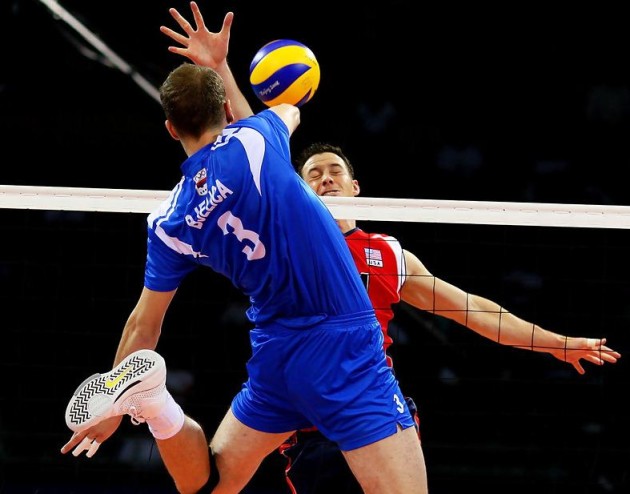
Volleyball
Help Each Other Out
You’re still teammates, even when things go wrong:
When someone makes an on-count mistake the natural tendency is to shun and isolate them. This just makes them an easier target – its better to take a step toward them and help them out. Always remember: if they get beat, you get beat.
Waiting To Kill
Hyo-sen offers this formula for outside hitters:
On outside attacks, don’t go half speed and meet the ball at the net. Wait a second longer and then EXPLODE to the ball. The consequence is more energy which means a higher jump and harder hit.
Serving More Aces, Part 6
Another way to score more aces is to be on the look out for a player who looks overly frustrated, upset, tired or injured. Any of those signs should be a flag for your serve. That player isn’t in the game as much as they should, so hit them and see if they can pull it together.
Effective Blocking, Part 2
After watching the pass, turn your attention to the setter, trying to pick up clues to where the set is likely to go.
If the ball is far in from of the setter, the set will usually go forward. If they try to move to a place where they can get the ball closer to the center of the head, it will likely be a back set.
Some setters have a tendency to use a jump set when setting middle.
Watch the setter throughout the game, and you’ll find you can often pick up valuable clues as to where the ball is going, even before the set is made.
Setters are human, and get into rhythms and certain body positions when they’re setting. Watch and learn your opponent’s body language. You can use that knowledge to your advantage.
Be the Air Traffic Controller
In center back, you have the best view of what’s going on, so you owe it to your teammates to become the air traffic controller.
You can see the plays develop, you can see if balls are in or out, you can see touches, you’ve got the best view in the house. So share all that information with your teammates, and everyone will benefit.
Middle Blockers, Reading Setters
Middle blockers rule the net. They need to be warriors, constantly in motion, relentlessly aggressive on offense and defense.
Here’s a tip for playing tough CF:
When blocking the quick set, look where the setter is. Is she too far back to set it effectively? If so, wait, and expect a regular set, or something outside.
Serving More Aces, Part 4
Another player who should get a serve right away is a player who just enters the game. That player hasn’t had time to get into the flow of the game, isn’t quite warmed up, and is going to have the adreneline flowing and liable to be a little nervous and slightly uptight. Hit them while all that is in your favor. Even if they’re a good passer, they’ll often miss one or two at the very beginning of their rotation.
Reading Hitters, Part 7
Once you’ve made all your mental calculations about the flight of the ball, you’ll need to shift your attention to the hitter. Watch the hitter’s approach, where they begin, and the way they move toward the ball.
If a set is high outside, and the hitter must come at the ball from outside the sideline, the ball MUST be hit angle, since that’s the only way the ball can legally cross the net between the antennas. The farther out the hitter must go, the sharper the angle of the hit must be.
Snap Your Wrist
Remember: the snap of the wrist at the end of your spike is the most important part of the hitting motion. Snapping your wrist will make it much less likely for your hit to sail out the back, because it puts a downward spin on the ball, causing it to curve toward the floor.
The Jump Serve, Part 1
The jump serve can be a devastating weapon, but it must be executed properly.
Step One in learning the jump serve involves where you stand to begin. You have to give yourself enough room to make what boils down to a spiking approach, which generally means you’ll need to start far enough back to allow you to take two fairly large steps.
Check out more news from our Did You Know? section.
Read articles from out Fitness section, every Saturday a new story! Tomorrow read about Top 3 Exercises That Burn the Most